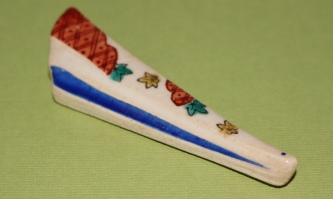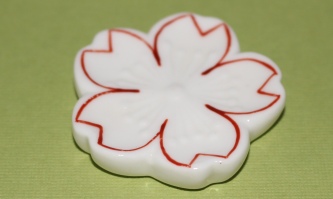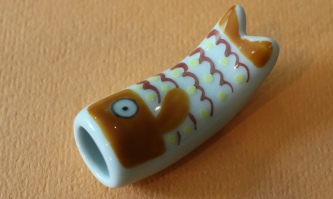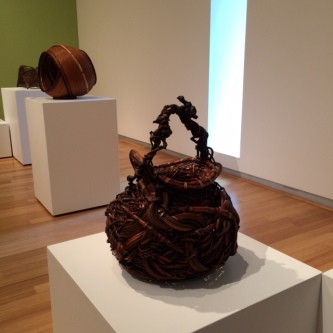The origin of hashioki is difficult to date.
Historians believe that chopsticks originated in China, and that they were first imported to neighboring countries sometime after the fifth century BCE. In Japan chopsticks were probably initially used solely by the imperial court and nobility, the people who interacted with Chinese and Korean emissaries; many chopsticks have been discovered in the excavations of the first permanent capital that was constructed near Nara, Japan beginning in 710 CE. Prior to the introduction of chopsticks the Japanese people, like many of their global contemporaries, ate with their hands, or sipped liquids like soup from bowls. However, archeological excavations outside of Kyoto suggest that chopsticks were in common use by the general population by the end of the eighth century.(1) This pebble shaped hashioki has been glazed and fired in the style of many ceramics from that period.
excavations of the first permanent capital that was constructed near Nara, Japan beginning in 710 CE. Prior to the introduction of chopsticks the Japanese people, like many of their global contemporaries, ate with their hands, or sipped liquids like soup from bowls. However, archeological excavations outside of Kyoto suggest that chopsticks were in common use by the general population by the end of the eighth century.(1) This pebble shaped hashioki has been glazed and fired in the style of many ceramics from that period.
Unfortunately, the origin of hashioki is less certain. Some commentators suggest there is a connection to rituals performed in Shintoism, the indigenous spiritual system of Japan  associated with nature, where the chopsticks used to offer ritual foods to the gods were placed on a stand to keep them uncontaminated.(2) This cherry tree bark hasioki could be considered to express the Shinto emphasis on natural materials. An illustration in the Shijōke shichigosan no kazarikata (Shijō-House Decorations for 7-5-3 Trays), a Japanese culinary text dated 1612, features what appears to be a hashioki in diagrams for two banquet trays, although in this drawing the center of the chopsticks are balanced on the hashioki like a seesaw,(3) not simply supporting the tips, as they are used today. Because this text is essentially an interpretation of Chinese practices for ceremonial occasions, it supports the idea that hashioki, like chopsticks, are items that may have originated in China.
associated with nature, where the chopsticks used to offer ritual foods to the gods were placed on a stand to keep them uncontaminated.(2) This cherry tree bark hasioki could be considered to express the Shinto emphasis on natural materials. An illustration in the Shijōke shichigosan no kazarikata (Shijō-House Decorations for 7-5-3 Trays), a Japanese culinary text dated 1612, features what appears to be a hashioki in diagrams for two banquet trays, although in this drawing the center of the chopsticks are balanced on the hashioki like a seesaw,(3) not simply supporting the tips, as they are used today. Because this text is essentially an interpretation of Chinese practices for ceremonial occasions, it supports the idea that hashioki, like chopsticks, are items that may have originated in China.
British scholar Charles J. Dunn claims that hashioki were used by more affluent Japanese households during the Tokugawa period (1603-1868).(4) This ivory-colored porcelain rest its asymmetrical floral design and gold embellishment is typical of the Satsuma ceramics popular during that period.
households during the Tokugawa period (1603-1868).(4) This ivory-colored porcelain rest its asymmetrical floral design and gold embellishment is typical of the Satsuma ceramics popular during that period.
H. Elliott McClure, an American ornithologist and hashioki collector who lived in Japan during the 1950s, and the author of the only article on hashioki published in an English-language scholarly journal to date, believed that hashioki are a “modern innovation… probably not used before the turn of the [twentieth] century.”(5)
Even if chopstick rests existed in Japan prior to 1900, they became much more popular after this time in response to several trends. First, this period coincided with the establishment of depāto, or department stores in Japan. These department stores fueled the growth of a consumer culture in Japan,(6) specifically among the merchant and artisan classes, which now constituted a middle class with money to spend. Anthropologist Millie Creighton points out that while the department stores sell Western goods in Japan, they also sell domestic products, and as such are “involved in the creation  of cultural meanings… they are also curators of Japanese tradition, re-defining the meanings associated with a Japanese heritage.”(7) For example, this blue and white speckled hyotan or gourd, purchased in a Mitsukoshi department store, is a traditional good luck symbol, and also reflects the Japanese affinity for forms from nature. Today the housewares departments of Japanese depāto continue to offer some of the largest and most varied assortments of hashioki, including many hashioki featuring traditional motifs.
of cultural meanings… they are also curators of Japanese tradition, re-defining the meanings associated with a Japanese heritage.”(7) For example, this blue and white speckled hyotan or gourd, purchased in a Mitsukoshi department store, is a traditional good luck symbol, and also reflects the Japanese affinity for forms from nature. Today the housewares departments of Japanese depāto continue to offer some of the largest and most varied assortments of hashioki, including many hashioki featuring traditional motifs.
Second, the beginning of the twentieth century saw a dramatic change in the dining habits of the Japanese. Historian Jordan Sand notes that prior to the early 1900s “members of Japanese families generally dined at different times, sometimes in different rooms, from individual trays.”(8) This meant most people ate in silence. Sand refers to a Japanese household management guide and moral instruction guide published in 1907 titled Ie (Household) which introduced the idea that ‘houses of the middle level of society (chūtō shakai) should make a custom whenever possible of gathering the whole family for meals.’ Meals should be taken in the most pleasant place in the house, conversation should be encouraged, and ‘to the degree possible, trays should be abandoned for a table structure…’”(9) Ethnographer Naomichi Ishige reports that by the mid 1920s most Japanese families had transitioned to low communal tables called chabudai, which were largely replaced by a Western-style dining table by the 1970s.(10) Hashioki like this hand-painted crescent, which allowed a diner to pause and lay down his or her chopsticks during a meal, are one device that could facilitate conversation at a communal table.
had transitioned to low communal tables called chabudai, which were largely replaced by a Western-style dining table by the 1970s.(10) Hashioki like this hand-painted crescent, which allowed a diner to pause and lay down his or her chopsticks during a meal, are one device that could facilitate conversation at a communal table.
Third, while Japan was bombarded with Western influences after the opening of the country to trade with the West in 1854, this actually encouraged some citizens to become nostalgic for traditional items. Design historian Penny Sparke confirms this trend when she notes that in the hundred years beginning in the 1870s “as [Japan] gradually embraced a way of life inspired by the West, design developed erratically, sometimes moving enthusiastically forward, fired by  advances in technology, and sometimes resisting advancement, mirroring and reinvigorating the continuing role of tradition and spirituality in everyday life.”(11) Hashioki, like this one in the shape of a folded fan, brought traditional symbols to the dining table, and also facilitated the use of traditional chopsticks instead of Western cutlery.
advances in technology, and sometimes resisting advancement, mirroring and reinvigorating the continuing role of tradition and spirituality in everyday life.”(11) Hashioki, like this one in the shape of a folded fan, brought traditional symbols to the dining table, and also facilitated the use of traditional chopsticks instead of Western cutlery.
Finally, domestic travel by Japanese citizens, including recreational tourism to famous sites throughout Japan, expanded significantly during the twentieth century. After World War 2 the number of foreign tourists visiting Japan also increased. So the new market created by tourists shopping for souvenirs, like this stylized cherry blossom, may have fueled hashioki growth. Anyone who has been to Japan will attest to the lines of shops along the approaches to temples and shrines, and the kiosks that line the hallways of railroad stations, that exist solely to provide keepsakes for travelers, or for the folks back home. There are always a few shops selling plates and cups and chopstick rests; hashioki make attractive souvenirs that are both inexpensive and easy to carry.
created by tourists shopping for souvenirs, like this stylized cherry blossom, may have fueled hashioki growth. Anyone who has been to Japan will attest to the lines of shops along the approaches to temples and shrines, and the kiosks that line the hallways of railroad stations, that exist solely to provide keepsakes for travelers, or for the folks back home. There are always a few shops selling plates and cups and chopstick rests; hashioki make attractive souvenirs that are both inexpensive and easy to carry.
My takeaway from this timeline is that during a century of dynamic economic growth and societal metamorphosis hashioki have been hashi, or bridges, spanning a river of change.
(1) Ishige, Naomichi. The History and Culture of Japanese Food. London: Keegan Paul, 2001, p. 67.
(2) Kikkoman Corporation. Chopsticks (O-hashi). http://kikkoman.com/cookbook/glossarygs4.shtml (downloaded March 2011), p. 1.
(3) Rath, Eric C. Food and Fantasy in Early Modern Japan. Berkeley: University of California Press, 2010, Plate 5.
(4) Dunn, Charles J. Everyday Life in Traditional Japan. North Clarendon, Vermont: Tuttle Publishing, 1969, p. 136.
(5) McClure, H. Elliott. Hashioki: Art of the Chopstick Rest. Orientations, June 1979, p. 45.
(6) Tamari, Tomoko. “Rise of the Department Store and the Aestheticization of Everyday Life in 20th. Century Japan.” International Journal of Japanese Sociology. 2006 (November: Number 15), p.100.
(7) Creighton, Millie. “Pre-industrial dreaming in post-industrial Japan: department stores and the commoditization of community traditions.” Japan Forum 1998, 10 (2), p. 127.
(8) Sand, Jordan. House and Home in Modern Japan: Architecture, Domestic Space and Bourgeois Culture 1880-1930. Cambridge: Harvard University Press, 2003, p. 33.
(9) Ibid., p. 34.
(10) Ishige, Naomichi. “Food Culture,” in Sugimoto, Yoshio (ed.) The Cambridge Companion to Modern Japanese Culture. Cambridge: Cambridge University Press, 2009, p. 310.
(11) Sparke, Penny. Japanese Design. New York: Museum of Modern Art, 2009, p. 13.
 Sometimes differences in decoration go beyond color. Pebble-shaped hashioki with Chinese-style landscapes, like these examples, are also popular in Japan. However, the version on the right is not just multi-colored but is also a completely different scene with a unique border treatment.
Sometimes differences in decoration go beyond color. Pebble-shaped hashioki with Chinese-style landscapes, like these examples, are also popular in Japan. However, the version on the right is not just multi-colored but is also a completely different scene with a unique border treatment.







 The tale relates how an elderly woodcutter discovered an injured sparrow in the woods. He took it home and asked his wife to feed and nurse the sparrow, but she resented sharing their meager food supply with a bird. One day when the old woman’s back was turned the starving sparrow ate some rice she had left on a table, and she cut its tongue out as punishment. The sparrow fled into the forest. When her woodcutter husband went searching for the bird he was greeted by a flock of sparrows who led him to the sparrow’s home for a big feast. When the old man was leaving the now-recovered sparrow told him he wanted to give him a thank you gift, and he offered the woodcutter a choice between a large and a small basket. Being a modest man, the woodcutter chose the small basket. When he arrived home he discovered the basket was filled with a fortune in gold coins. Instead of rejoicing, his wife berated him for not taking the larger basket, and she ran into the woods, found the sparrow and his friends, and demanded the larger basket. They gave it to her, but before she arrived home she discovered that her basket was filled with poisonous snakes who frightened her to death.
The tale relates how an elderly woodcutter discovered an injured sparrow in the woods. He took it home and asked his wife to feed and nurse the sparrow, but she resented sharing their meager food supply with a bird. One day when the old woman’s back was turned the starving sparrow ate some rice she had left on a table, and she cut its tongue out as punishment. The sparrow fled into the forest. When her woodcutter husband went searching for the bird he was greeted by a flock of sparrows who led him to the sparrow’s home for a big feast. When the old man was leaving the now-recovered sparrow told him he wanted to give him a thank you gift, and he offered the woodcutter a choice between a large and a small basket. Being a modest man, the woodcutter chose the small basket. When he arrived home he discovered the basket was filled with a fortune in gold coins. Instead of rejoicing, his wife berated him for not taking the larger basket, and she ran into the woods, found the sparrow and his friends, and demanded the larger basket. They gave it to her, but before she arrived home she discovered that her basket was filled with poisonous snakes who frightened her to death. messengers. In addition, live foxes continue to inhabit the four main islands of Japan. And because fried tofu is inexplicably the favorite food of otherwise carnivorous kitsune, foxes are also evoked in the popular Japanese snack food inari sushi, where fried tofu pouches are filled with rice and the corners are turned down to look like fox ears.
messengers. In addition, live foxes continue to inhabit the four main islands of Japan. And because fried tofu is inexplicably the favorite food of otherwise carnivorous kitsune, foxes are also evoked in the popular Japanese snack food inari sushi, where fried tofu pouches are filled with rice and the corners are turned down to look like fox ears. Japanese folklore foxes are often portrayed as cunning shape-shifters. An evil fox can transform him or herself into something as innocuous as a teapot, or into an attractive and sexy female. In one popular folktale a fox marries a man after mutating into the form of a human female.
Japanese folklore foxes are often portrayed as cunning shape-shifters. An evil fox can transform him or herself into something as innocuous as a teapot, or into an attractive and sexy female. In one popular folktale a fox marries a man after mutating into the form of a human female.
 early May. Shaped like fish, their name means “carp streamers.” They are associated with May 5, a national Japanese holiday known as Children’s Day. Prior to 1948 this holiday was known as Boys’ Day, and it was the custom to hang one koi no bori steamer for each male child in the family outside the house.
early May. Shaped like fish, their name means “carp streamers.” They are associated with May 5, a national Japanese holiday known as Children’s Day. Prior to 1948 this holiday was known as Boys’ Day, and it was the custom to hang one koi no bori steamer for each male child in the family outside the house. man’s quest to obtain fame and fortune in life against daunting odds.The folk hero Kintarō is also associated with the May 5 holiday, and he is often depicted riding on a carp (please see my March 2016 post “Kintarō”.)
man’s quest to obtain fame and fortune in life against daunting odds.The folk hero Kintarō is also associated with the May 5 holiday, and he is often depicted riding on a carp (please see my March 2016 post “Kintarō”.) windsocks decorating parks and other public places during the first week of May. Once made of paper of silk, koi no bori today are screen printed on nylon, and are almost as weather resistant as the fish that inspired them.
windsocks decorating parks and other public places during the first week of May. Once made of paper of silk, koi no bori today are screen printed on nylon, and are almost as weather resistant as the fish that inspired them. excavations of the first permanent capital that was constructed near Nara, Japan beginning in 710 CE. Prior to the introduction of chopsticks the Japanese people, like many of their global contemporaries, ate with their hands, or sipped liquids like soup from bowls. However, archeological excavations outside of Kyoto suggest that chopsticks were in common use by the general population by the end of the eighth century.(1) This pebble shaped hashioki has been glazed and fired in the style of many ceramics from that period.
excavations of the first permanent capital that was constructed near Nara, Japan beginning in 710 CE. Prior to the introduction of chopsticks the Japanese people, like many of their global contemporaries, ate with their hands, or sipped liquids like soup from bowls. However, archeological excavations outside of Kyoto suggest that chopsticks were in common use by the general population by the end of the eighth century.(1) This pebble shaped hashioki has been glazed and fired in the style of many ceramics from that period. associated with nature, where the chopsticks used to offer ritual foods to the gods were placed on a stand to keep them uncontaminated.(2) This cherry tree bark hasioki could be considered to express the Shinto emphasis on natural materials. An illustration in the Shijōke shichigosan no kazarikata (Shijō-House Decorations for 7-5-3 Trays), a Japanese culinary text dated 1612, features what appears to be a hashioki in diagrams for two banquet trays, although in this drawing the center of the chopsticks are balanced on the hashioki like a seesaw,(3) not simply supporting the tips, as they are used today. Because this text is essentially an interpretation of Chinese practices for ceremonial occasions, it supports the idea that hashioki, like chopsticks, are items that may have originated in China.
associated with nature, where the chopsticks used to offer ritual foods to the gods were placed on a stand to keep them uncontaminated.(2) This cherry tree bark hasioki could be considered to express the Shinto emphasis on natural materials. An illustration in the Shijōke shichigosan no kazarikata (Shijō-House Decorations for 7-5-3 Trays), a Japanese culinary text dated 1612, features what appears to be a hashioki in diagrams for two banquet trays, although in this drawing the center of the chopsticks are balanced on the hashioki like a seesaw,(3) not simply supporting the tips, as they are used today. Because this text is essentially an interpretation of Chinese practices for ceremonial occasions, it supports the idea that hashioki, like chopsticks, are items that may have originated in China. households during the Tokugawa period (1603-1868).(4) This ivory-colored porcelain rest its asymmetrical floral design and gold embellishment is typical of the Satsuma ceramics popular during that period.
households during the Tokugawa period (1603-1868).(4) This ivory-colored porcelain rest its asymmetrical floral design and gold embellishment is typical of the Satsuma ceramics popular during that period. of cultural meanings… they are also curators of Japanese tradition, re-defining the meanings associated with a Japanese heritage.”(7) For example, this blue and white speckled hyotan or gourd, purchased in a Mitsukoshi department store, is a traditional good luck symbol, and also reflects the Japanese affinity for forms from nature. Today the housewares departments of Japanese depāto continue to offer some of the largest and most varied assortments of hashioki, including many hashioki featuring traditional motifs.
of cultural meanings… they are also curators of Japanese tradition, re-defining the meanings associated with a Japanese heritage.”(7) For example, this blue and white speckled hyotan or gourd, purchased in a Mitsukoshi department store, is a traditional good luck symbol, and also reflects the Japanese affinity for forms from nature. Today the housewares departments of Japanese depāto continue to offer some of the largest and most varied assortments of hashioki, including many hashioki featuring traditional motifs. had transitioned to low communal tables called chabudai, which were largely replaced by a Western-style dining table by the 1970s.(10) Hashioki like this hand-painted crescent, which allowed a diner to pause and lay down his or her chopsticks during a meal, are one device that could facilitate conversation at a communal table.
had transitioned to low communal tables called chabudai, which were largely replaced by a Western-style dining table by the 1970s.(10) Hashioki like this hand-painted crescent, which allowed a diner to pause and lay down his or her chopsticks during a meal, are one device that could facilitate conversation at a communal table. advances in technology, and sometimes resisting advancement, mirroring and reinvigorating the continuing role of tradition and spirituality in everyday life.”(11) Hashioki, like this one in the shape of a folded fan, brought traditional symbols to the dining table, and also facilitated the use of traditional chopsticks instead of Western cutlery.
advances in technology, and sometimes resisting advancement, mirroring and reinvigorating the continuing role of tradition and spirituality in everyday life.”(11) Hashioki, like this one in the shape of a folded fan, brought traditional symbols to the dining table, and also facilitated the use of traditional chopsticks instead of Western cutlery. created by tourists shopping for souvenirs, like this stylized cherry blossom, may have fueled hashioki growth. Anyone who has been to Japan will attest to the lines of shops along the approaches to temples and shrines, and the kiosks that line the hallways of railroad stations, that exist solely to provide keepsakes for travelers, or for the folks back home. There are always a few shops selling plates and cups and chopstick rests; hashioki make attractive souvenirs that are both inexpensive and easy to carry.
created by tourists shopping for souvenirs, like this stylized cherry blossom, may have fueled hashioki growth. Anyone who has been to Japan will attest to the lines of shops along the approaches to temples and shrines, and the kiosks that line the hallways of railroad stations, that exist solely to provide keepsakes for travelers, or for the folks back home. There are always a few shops selling plates and cups and chopstick rests; hashioki make attractive souvenirs that are both inexpensive and easy to carry. is so popular in Asian ceramics. This fish is shown in a position that I suspect is anatomically impossible for a fish – basically the fish is trying to do a sit-up – but I think the pose is supposed to suggest a fish frolicking or jumping in the waves. The vendor on eBay who sold this fish said that it was an “estate sale find,” and I think the fish has a kind of old-fashioned, pre-Pacific War vibe to it. Even though it’s not as detailed as my first fish, I think this little green guy is also charming.
is so popular in Asian ceramics. This fish is shown in a position that I suspect is anatomically impossible for a fish – basically the fish is trying to do a sit-up – but I think the pose is supposed to suggest a fish frolicking or jumping in the waves. The vendor on eBay who sold this fish said that it was an “estate sale find,” and I think the fish has a kind of old-fashioned, pre-Pacific War vibe to it. Even though it’s not as detailed as my first fish, I think this little green guy is also charming. Dragon,” and it’s by a Japanese artist named Yufu Shohaku.
Dragon,” and it’s by a Japanese artist named Yufu Shohaku.